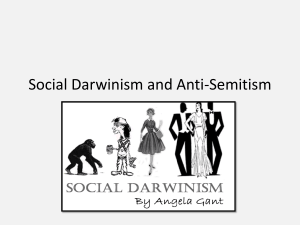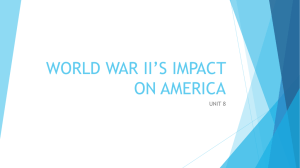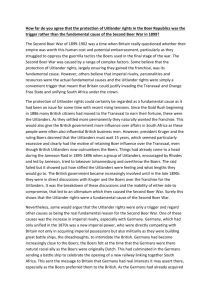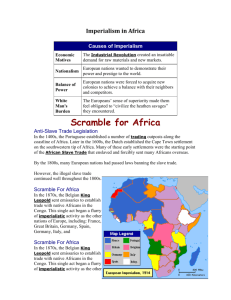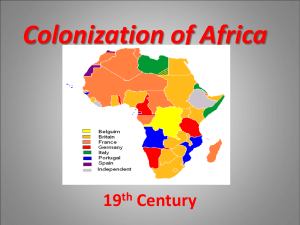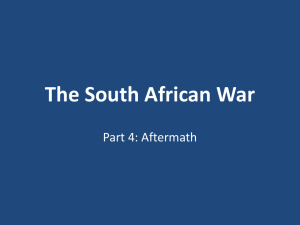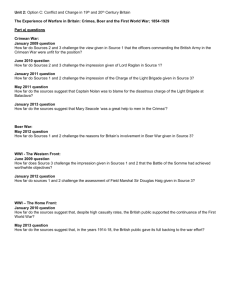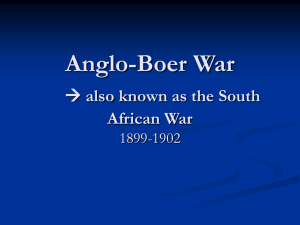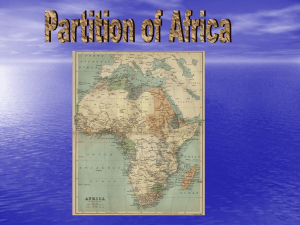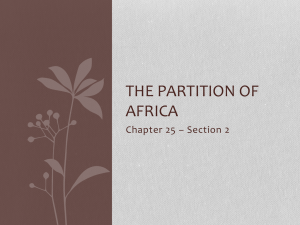course_of_sa_war_ppt2
advertisement
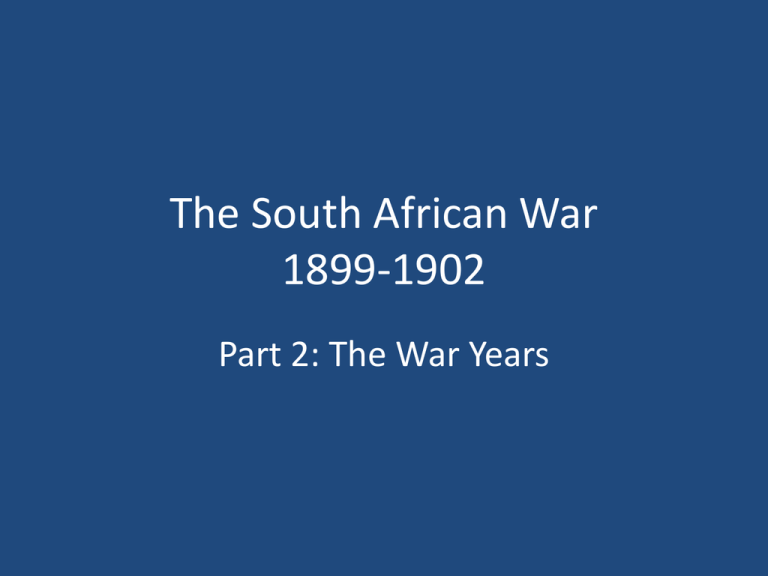
The South African War 1899-1902 Part 2: The War Years Review of the Causes of the War • The treatment of the Uitlanders in the Transvaal. • To secure the Cape. British naval base at Simonstown and route to the east. • To consolidate British Imperialist control of the whole southern African region. • To control the wealth of Witwatersrand’s Gold deposits. The South African War • 11 October 1899 – 31 May 1902 • A British victory (Treaty of Vereeniging) British ‘Boer’ Britain South African Republic / (Transvaal) Orange Free State British Empire: Cape Colony, Natal, Rhodesia, Australia, India, New Zealand Foreign Volunteers: Dutch, German, Scandinavian, Russian, French, American, Irish, Polish, Portuguese, Flemish, Italian and Australian Phase 1: Conventional Warfare (1899-1900) British Troops: • When war broke out: 20,000 British troops were stationed in Cape and Natal. By end of 1900 250,000 more soldiers sent to SA By end of war 400,000 British soldiers used Boer Troops • When war broke out: 1000 state artillery and 1 400 state police in Republics. Only 75 government guns! + 55 000 armed civilians Civilian vs Professional Phase 1: Conventional warfare (1899-1900) • Boers struck first in 1899 and besieged Mafeking (217 days), Kimberley (124 days) and Ladysmith (118 days) – a tactical mistake? • Initial Boer victories at Colenso, Magersfontein and Spion Kop (British called it ‘Black Week’) • Early in 1900 British troops relieved the 3 beseiged towns. • 4 April 1900 British raised Union Jack in Bloemfontein, June 1900 Pretoria captured. • The British thought the war was over but……. Phase 2: Guerrilla Warfare (1900-02) Boers governed from the Veld Phase 2: Guerrilla Warfare (1900-02) Boer Guerilla Tactics: - Blew up and destroyed railway lines and captured stores (food, ammunition) - Cut telegraph wires (slowing down communication links) - Surprise attacks: ‘Hit-and-run’ - NB: Boers were excellent horsemen, superior knowledge of the countryside, scouting skills - At least 10,000 Black agterryers (afterriders) accompanied Boer commados as auxilliaries. - Leaders associated with this phases: Christiaan de Wet, Koos de la Rey, Louis Botha, Jan Smuts Phase 2: Guerrilla Warfare 1900-1902 - British Responses • Scorched Earth Policy: Aim: cut off supplies of food and intelligence to Boers on Commando. - Boer farms blown up (approx 30,000 burned down) - Livestock slaughtered, crops burned. - More than 40 small rural towns destroyed. (NB: Consider the human as well a military and economic impact of this policy) Implementing Scorched Earth Policy This picture by Richard Caton Woodville shows a Boer woman standing up to the brutality of British soldiers who were busy destroying her home. Implementing Scorched Earth Policy Note the woman sitting on a small pile of belongings watching as her home was burned to the ground by British soldiers. Phase 2: Guerrilla Warfare 1900-1902 - British Responses • Concentration Camps Aim: To hold Boers hostage; to prevent women supplying food and intelligence to commandos; a practical solution to homelessness. - Boer women, children and elderly (and black farm labourers) interned in camps. - At least 27,927 Boer civilians died in camps (81% were children) – this was more than 10% of the total Afrikaner population of two republics. - At least 15,000 Black people died in camps (no accurate records have survived). Accommodation Housed in overcrowded ‘Bell Tents’ (10-18 people per tent) Consider the impact of wind, rain, dew, heat, cold in this context. An example of the death rates at one camp: Bethulie Camp in the OFS Why were the death rates so high? • Tents were overcrowded so any infectious disease spread quickly. • Inadequate food supply: little meat, no fruit, vegetables or fresh milk. • Cold and damp or hot and dusty • Lack of adequate sanitation facilities and water in many camps • No soap for most of war • There was a chronic shortage of medical supplies and medical staff. Waiting for Food Rations Kitchener ordered that rations be given as follows: 1st class – families of neutrals, surrendered or non-combatants. 2nd class – families of men on commando. Waiting for Water A child suffering extreme malnutrition at Bloemfontein Concentration Camp Emily Hobhouse • Visited concentration camps Jan-April 1901 • Disclosed the terrible living conditions. Her report caused questions to be asked in British parliament. • 1901 War Office sent committee of ladies sent to SA under Millicent Fawcett → reforms in admin of camps, eg: soap, fruit and vegetables → The death rate dropped. Phase 2: Guerrilla Warfare 1900-1902 - British Responses • Blockhouses and Barbed Wire Aim: to divide the whole country into fenced sections which would slow the movement of the Boers and make them easier to capture. • Prisoners of War - 25, 000 Boer soldiers were transported over seas (eg: to St Helena) Aim: reduce morale The War Ends • Treaty of Vereeniging in 1902 • Boers are forced to accept British rule under following conditions: – Protection of Dutch language (Afrikaners) – Property rights – Promise of eventual self-government – Agreement that no rights would be given to blacks until an organized government was set up Casualties Military casualties 22,000 British soldiers died (35% in action 65% of disease) (80% of men presenting for service in the Boer War were found by the Army Medical Corps to be physically unfit to fight.) 4,000 Boer soldiers died Unknown how many black soldiers and agterryers died Civilian casualties: • 27,927 Boer civilians died in concentration camps • At least 15,00 Black people died in camps.
